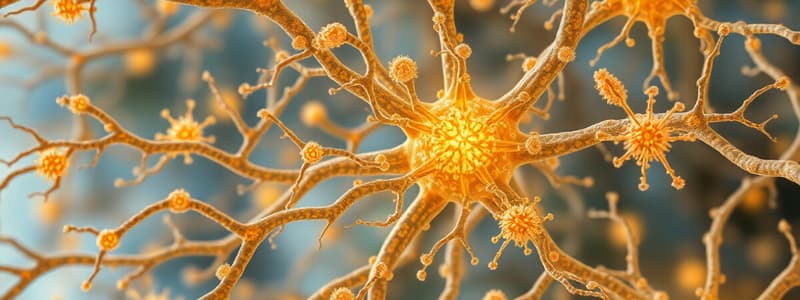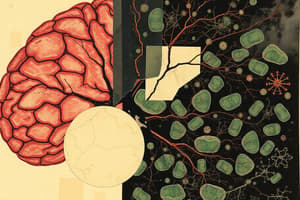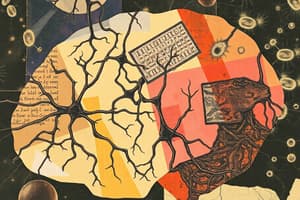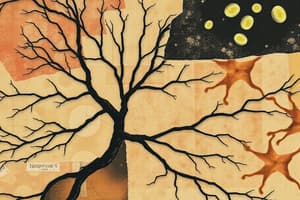Podcast
Questions and Answers
Dendrites contain Nissl bodies.
Dendrites contain Nissl bodies.
False (B)
Sensory neurons conduct nerve impulse to the CNS.
Sensory neurons conduct nerve impulse to the CNS.
True (A)
Synapses are structures responsible for the transmission of nerve impulses from one neuron to the other.
Synapses are structures responsible for the transmission of nerve impulses from one neuron to the other.
True (A)
Nissl bodies are present in perikaryon and dendrites.
Nissl bodies are present in perikaryon and dendrites.
Nissl bodies are represented by mitochondria.
Nissl bodies are represented by mitochondria.
Nodes of Ranvier are interruptions occurring in the myelin sheaths at regular intervals along the length of the axon.
Nodes of Ranvier are interruptions occurring in the myelin sheaths at regular intervals along the length of the axon.
Nervous tissue is vascularized.
Nervous tissue is vascularized.
Ependymocytes are present in the ganglia.
Ependymocytes are present in the ganglia.
Neuronal signals are conducted faster in electrical synapses than in chemical synapses.
Neuronal signals are conducted faster in electrical synapses than in chemical synapses.
Pseudounipolar neurons can be found in the olfactory epithelium.
Pseudounipolar neurons can be found in the olfactory epithelium.
Sensory neurons are efferent.
Sensory neurons are efferent.
Flashcards
Dendrites and Nissl bodies
Dendrites and Nissl bodies
Dendrites contain Nissl bodies, which are rough endoplasmic reticulum aggregates.
Sensory Neurons
Sensory Neurons
Sensory neurons conduct nerve impulses to the central nervous system (CNS).
Synapses
Synapses
Synapses are structures that transmit nerve impulses from one neuron to another.
Nodes of Ranvier
Nodes of Ranvier
Signup and view all the flashcards
Ependymocytes
Ependymocytes
Signup and view all the flashcards
Protoplasmic astrocytes
Protoplasmic astrocytes
Signup and view all the flashcards
Schwann Cells
Schwann Cells
Signup and view all the flashcards
Oligodendrocytes
Oligodendrocytes
Signup and view all the flashcards
Lymphocytes
Lymphocytes
Signup and view all the flashcards
Basophils
Basophils
Signup and view all the flashcards
Megakaryocytes
Megakaryocytes
Signup and view all the flashcards
Erythropoiesis
Erythropoiesis
Signup and view all the flashcards
ThromboPOIETIN
ThromboPOIETIN
Signup and view all the flashcards
Clonal expansion
Clonal expansion
Signup and view all the flashcards
Thymus
Thymus
Signup and view all the flashcards
Adaptive immunity
Adaptive immunity
Signup and view all the flashcards
Type II pneumocytes
Type II pneumocytes
Signup and view all the flashcards
Respiratory bronchioles
Respiratory bronchioles
Signup and view all the flashcards
Interalveolar septa
Interalveolar septa
Signup and view all the flashcards
MALT
MALT
Signup and view all the flashcards
Alveolar macrophages
Alveolar macrophages
Signup and view all the flashcards
Platelets
Platelets
Signup and view all the flashcards
Trachea structure
Trachea structure
Signup and view all the flashcards
Ventilation
Ventilation
Signup and view all the flashcards
Pulmonary surfactant
Pulmonary surfactant
Signup and view all the flashcards
Skin layers
Skin layers
Signup and view all the flashcards
Langerhans cells
Langerhans cells
Signup and view all the flashcards
Eccrine glands
Eccrine glands
Signup and view all the flashcards
Melanocytes
Melanocytes
Signup and view all the flashcards
Study Notes
Nervous Tissue
- Dendrites contain Nissl bodies.
- Synapses transmit nerve impulses between neurons.
- Nissl bodies, present in the perikaryon and dendrites, are composed of ribosomes and rough endoplasmic reticulum.
- Nervous tissue is vascularised.
- Ganglia are clusters of neuron cell bodies outside the CNS.
- Motor neurons send impulses to effector organs.
- Sensory neurons conduct impulses to the CNS.
Glial Cells
- Protoplasmic astrocytes are found in gray matter of CNS.
- Schwann cells form myelin sheaths around axons in PNS.
- Glial cells provide metabolic and mechanical support to neurons.
- Ependymal cells line the ventricles of brain and central canal of spinal cord.
- Microglial cells are macrophages of CNS.
- Astrocytes regulate neuronal activity and metabolism.
- Astrocytes form pedicels (vascular feet).
Neurons
- Nissl bodies are located in the perikaryon and dendrites.
- Neurons are metabolically active cells.
- Most neurons have one axon and multiple dendrites.
- Multiple axons exist in multipolar neurons.
Ganglia
- Ganglia are comprised of neuron cell bodies and nerve fibers.
- Sensory ganglia are surrounded by a capsule.
- Multipolar neurons are found in autonomic ganglia.
- Pseudounipolar neurons are in sensory ganglia.
Unmyelinated Axons
- Schwann cells envelop multiple unmyelinated axons in PNS.
- Myelin sheaths don't wrap each axon in unmyelinated axons.
- Nodes of Ranvier are not present along unmyelinated nerve fibers.
- Schwann cells envelop just one axon in unmyelinated axons.
Epineurium
- Surrounds the entire nerve.
- Composed of dense irregular connective tissue.
- Contains blood vessels.
Neuroglia
- Satellite cells are located in ganglia.
- Oligodendrocytes are myelin-forming cells in the CNS.
- Ependymal cells line the central canal of spinal cord.
- Microglia are macrophages of CNS.
- Astrocytes are myelin-forming cells in the CNS.
- Astrocytes form pedicels (vascular feet).
Interneurons
- Can connect motor and sensory neurons.
- Are association neurons.
- Create the majority of neurons in the human CNS.
- Their axons are not always myelinated.
Neural Crest
- Molecules such as ephrin B1 and chondroitin sulfate proteoglycans are permissive for neural crest cell migration.
- Neural crest originates from mesenchyme.
Blood and Bone Marrow
- Plasma contains fibrinogen.
- Serum doesn't contain fibrinogen.
- Reticulocytes are immature red blood cells.
- Lymphocytes constitute 4–8% of circulating leukocytes.
- The biconcave shape of erythrocytes facilitates gas exchange.
- Leukocytes are the predominant cells of blood.
- Red blood cells can leave blood vessels by diapedesis.
- Megakaryocytes are large cells with polyploid nuclei.
- Megakaryocytes are part of mononuclear phagocyte system.
Hematopoietic Stem Cells
- All blood cells are derived from one hematopoietic stem cell.
- Stem cells have high potential for self-renewal.
Erythropoiesis
- Red blood cells develop from myeloid cells.
- Erythrocytes transport oxygen and carbon dioxide.
- Erythrocytes lack a nucleus.
- Erythrocytes have a biconcave shape.
Leukocytes
- Monocytes differentiate into macrophages.
- Monocytes constitute about 25-35% of leukocytes.
- Neutrophils are least numerous granulocytes.
Bone Marrow
- Yellow bone marrow is not found in adults.
- Red bone marrow is located in flat bones and vertebrae.
Lymphatic System
- The lymphatic system includes lymph nodes (with capsule), spleen (with capsule), and tonsils (without capsule).
- Lymph nodes are located in lymphatic vessels, filtering lymph.
- Some lymphatic organs are not encapsulated.
Thymus
- Belongs to central lymphoid organs.
- Doesn't produce immunoglobulins.
Lymph Nodes
- Lymph nodes are distributed along lymphatic vessels.
- They filter lymph, containing immune cells.
- Outer cortex contains lymph nodules.
Skin
- Epidermis is ectodermal in origin.
- Dermis is not of ectodermal origin.
- Keratinocytes are the primary cells in epidermis.
- Melanocytes produce melanin.
- Langerhans cells are antigen-presenting cells.
- Melanocytes reside in stratum basale of epidermis.
- Langerhans cells are found in stratum spinosum.
Respiratory System
- Trachea wall is comprised of mucosa, submucosa, and adventitia.
- Tracheal cartilage is C-shaped.
- Alveoli are lined with simple squamous epithelium.
- Type I pneumocytes make up most of the alveolar surface.
- Type II pneumocytes produce surfactant.
Trachea
- Trachea wall is composed of mucosa, submucosa, and adventitia.
- Tracheal cartilage is C-shaped.
- The open end of the cartilage rings is on its posterior part.
- The lamina propria contains elements of MALT.
Nasal Cavities
- The internal part of the nasal cavities are called nasal fossae.
- External portion of nasal cavities is called vestibule.
- Superior conchae are covered by olfactory epithelium.
- The nasal fossae communicate with paranasal sinuses.
- Mucous membrane of vestibule has vibrissae.
Alveolar Septa
- Alveolar septa have a dense network of capillaries.
- Alveolar septa contain elastic fibers and fibroblasts.
Clara Cells
- Located in bronchioles.
- Stem cells of bronchiolar exocrine cells.
Bronchus
- Contain cartilage plates in bronchial tree.
- Segmental bronchi are in number: 10 in R, 8 in L.
- Columnar cells with microvilli are called enterocytes or absorptive cells.
Ventilation Process
- The contraction of the diaphragm and intercostal muscles is a part of the ventilation process.
- Cilia movement of respiratory epithelium is also part of the process.
Lung Development
- Lung development begins in the 4th week of prenatal life. -The respiratory diverticulum is separated from the foregut by tracheoesophageal septum.
Studying That Suits You
Use AI to generate personalized quizzes and flashcards to suit your learning preferences.




